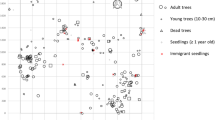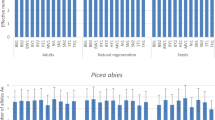Abstract
In this paper we first mathematically formulate spatial genetic models that rely on dispersal kernels, using the genetic inhomogeneous Poisson process. On the basis of mapped and genotyped data pertaining to adult and juvenile trees we are able to estimate three fundamental variables of population dynamics: individual female reproductive success, seed dispersal, and pollen flow. The model was applied to a secondary Fagus crenata stand in northern Japan, regenerated after shelterwood harvesting. Highly polymorphic microsatellite data revealed that most of the juveniles around one adult tree were not that tree’s progeny and that some minor alleles were clustered there. These data suggested that another mother tree had formerly been present in the vicinity, produced offspring there and died. Inferring its genotype and location, we applied the genetic inhomogeneous Poisson process. Results confirmed that we would have wrongly assessed the regeneration if we had been unaware of the existence of the dead mother. The average distances for seed dispersal and pollen flow were 18 and 193 m, respectively. The contribution of outside mothers, simultaneously assessed using the dispersal variables in the models, ranged from 10 to 50% depending on their positions relative to preserved adults. Individual female reproductive success varied as much as fiftyfold among the eight preserved adults. Our comprehensive approach, utilizing currently available genetic information, mathematical models, and previous forestry records, helped elucidation of the past forest-regeneration processes.






Similar content being viewed by others
References
Agestam E, Ekö PM, Nilsson U, Welander NT (2003) The effects of shelterwood density and site preparation on natural regeneration of Fagus sylvatica in southern Sweden. For Ecol Manage 176:61–73
Asuka Y, Tani N, Tsumura Y, Tomaru N (2004) Development and characterization of microsatellite markers for Fagus crenata Blume. Mol Ecol Notes 4:101–103
Austerlitz F, Dick CW, Dutech C, Klein EK, Oddou-Muratorio S, Smouse PE, Sork EK (2004) Using genetic markers to estimate the pollen dispersal curve. Mol Ecol 13:937–954
Batista JLF, Maguire DA (1998) Modeling the spatial structure of topical forests. For Ecol Manage 110:293–314
Boyden S, Binkley D, Shepperd W (2005) Spatial and temporal patterns in structure, regeneration, and mortality of an old-growth ponderosa pine forest in the Colorado Front Range. For Ecol Manage 219:43–55
Burczyk J, Chybicki IJ (2004) Cautions on direct gene flow estimation in plant populations. Evolution 58:956–963
Burczyk J, Adams WT, Moran GF, Griffin AR (2002) Complex patterns of mating revealed in a Eucalyptus regnans seed orchard using allozyme markers and the neighborhood model. Mol Ecol 11:2379–2391
Clark JS, Silman M, Kern R, Macklin E, HilleRisLambers J (1999) Seed dispersal near and far: patterns across temperate and tropical forests. Ecology 80:1475–1494
Cressie N (1993) Statistics for Spatial Data. Wiley, New York
Devlin B, Roeder K, Ellstrand NC (1988) Fractional paternity assignment: theoretical development and comparison to other methods. Theor Appl Genet 76:369–380
EI-Kassaby YA, Dunsworth BG, Krakowski J (2003) Genetic evaluation of alternative sulvicultural systems in coastal montane forests: western hemlock and amabilis fir. Theor Appl Genet 107:598–610
Finkeldey R, Ziehe M (2004) Genetic implications of silvicultural regimes. For Ecol Manage 197:231–244
Goto S, Shimatani K, Yoshimaru H, Takahashi Y (2006) Fat-tailed gene flow in the dioecious canopy tree species Fraxinus mandshurica var. japonica revealed by microsatellites. Mol Ecol 15:2985–2996
Johnson PS, Jacobs RD, Martin AJ, Godel ED (1989) Regenerating northern red oak: three successful case histories. North J Appl For 6:174–178
Kamitani T, Yoshida T (1991) The growth response of beech (Fagus crenata Blume) seedlings to the cutting of the overstory. J Jpn For Soc 73:154–157
Kitamoto N, Ueno S, Takenaka A, Tsumura Y, Washitani I, Ohsawa R (2006) Effect of flowering phenology on pollen flow distance and the consequences for spatial genetic structure within a population of Primula sieboldii (Primulaceae). Am J Bot 93:226–233
Kitamura K, Shimada K, Nakashima K, Kawano S (1997) Demographic genetics of the Japanese beech, Fagus crenata, at the Ogawa Forest Preserve, Ibaraki, Central Honshu, Japan. I. Spatial genetic substructuring in local population. Plant Species Biol 12:107–135
Maeda T (1988) Studies on natural regeneration of beech (Fagus crenata) (in Japanese with English summary). Special Bulletin of the College of Agriculture, Utsunomiya University 46:1–79
Masaki T, Sugita H, Kanazashi H, et al. (2003) Results of different managements for natural regeneration of two beech forests in Tohoku district and their ecological process (in Japanese with English Abstract). J Jpn For Soc 85:259–264
Oddou-Muratorio S, Klein EK, Austerlitz F (2005) Pollen flow in the wild service tree, Sorbus torminalis (L.) Crantz. II. Pollen dispersal and heterogeneity in mating success inferred from parent–offspring analysis. Mol Ecol 14:4441–4452
Pastorelli R, Smulders MJM, VAN’T Westende WPC, Vosman B, Giannini R, Vettori C, Vendramin GG (2003) Characterization of microsatellite markers in Fagus sylvatica L. and Fagus orientalis Lipsky. Mol Ecol Notes 3:76–78
Rajora OP, Pluhar SA (2003) Genetic diversity impacts of forest fires, forest harvesting, and alternative reforestation practices in black spruce (Picea mariana). Theor Appl Genet 106:1203–1212
Rajora OP, Rahman MH, Buchert GP, Dancik BP (2000) Microsatellite DNA analysis of genetic effects of harvesting in old-growth eastern white pine (Pinus strobus) in Ontario, Canada. Mol Ecol 9:339–348
Rathbun SL, Cressie N (1994) A space-time survival point process for a longleaf pine forest in Southern Georgia. J Am Stat Ass 89:1164–1174
Schlesinger RC, Sander IL, Davidson KR (1993) Oak regeneration potential increased by shelterwood treatments. North J Appl For 10:149–153
Shimatani K (2002) Point processes for fine-scale spatial genetics and molecular ecology. Biom J 44:325–352
Shimatani K (2004) Spatial molecular ecological models for genotyped adults and offspring. Ecol Model 174:401–410
Shimatani K, Kitamura K, Kanazashi T, Sugita H (2006) Genetic inhomogeneous Poisson processes describing the roles of an isolated mature tree in forest regeneration. Popul Ecol 48:203–214
Stoyan D, Penttinen A (2000) Recent applications of point process methods in forestry statistics. Stat Sci 15:61–78
Stoyan D, Stoyan H (1994) Fractals, random shapes and point fields. Methods of geometrical statistics. Wiley, Chichester
Stoyan D, Wagner S (2001) Estimating the fruit dispersion of anemochorous forest trees. Ecol Model 145:35–47
Sugita H (2005) Annual fluctuation during an 11 year period in seedfall, seedling emergence and seedling disappearance of Fagus crenata at the Ohtakizawa Research Site, the Omyojin Experimental Forest of Iwate University, northern Japan. Tohoku J For Sci 10:28–36
Sugita H, Kanazashi T, Masaki T (2006) Regeneration of Fagus crenata experimentally managed by a shelterwood system 33 or 54 years after cutting in forests with deciduous shrub-type undergrowth in the Tohoku District, northern Honshu, Japan. J Jpn For Soc 86:456–464 (in Japanese with English Abstract)
Suyama Y (2004) Identification of mother trees based on microsatellite analysis of maternal tissues from seeds, fruits, and seedlings (in Japanese with English Abstract). J Jpn For Soc 86:177–183
Suyama Y, Tomita M, Takahashi M et al (2002) Identification of the maternal trees for current-year seedlings of Fagus crenata based on microsatellite analysis. Proceedings of the VIII INTECOL (international congress of ecology), August 11–18, Seoul, Korea, p 258
Suzuki W, Osumi K, Masaki T (2005) Mast seedling and its spatial scale in Fagus crenata in northern Japan. For Ecol Manage 205:105–116
Takahashi M, Mukouda M, Koono K (2000) Differences in genetic structure between two Japanese beech (Fagus crenata Blume) stands. Heredity 84:103–115
Thomas BR, Macdonald SE, Hicks M, Adams DL, Hodgetts RB (1999) Effects of reforestation methods on genetic diversity of logepole pine: an assessment using microsatellite and randomly amplified polymorphic DNA markers. Theor Appl Genet 98:793–801
Yanagiya S, Kon T (1980) The results of natural regeneration under shelterwood management system in Fagus crenata forest: case study in deciduous shrub ground cover (in Japanese). Jpn For J Tohoku 32:66–69
Yanagiya S, Kon T, Konishi A (1969) The results of natural regeneration with bush clearing by remaining tree management system in Buna (Fagus crenata) forest (in Japanese). Annu Rep Tohoku Branch For Exp Stat 10:124–135
Yasaka M, Terazawa K, Koyama H, Kon H (2003) Masting behavior of Fagus crenata in northern Japan: spatial synchrony and pre-dispersal seed predation. For Ecol Manage 184:277–284
Acknowledgments
We thank Dr Kanazashi and Dr Masaki for their collaboration in field studies and for forestry discussion. This study was supported by Grants-in-Aid for Scientific Research (no. 15780112) from the Ministry of Education, Culture, Sports, Science, and Technology, Japan, and ISM Cooperative Research 15-2049 and 16-2057.
Author information
Authors and Affiliations
Corresponding author
Appendix
Appendix
Materials, methods, and results of isozyme analysis
In June 2004, we collected fresh leaf tissues from:
-
1
sixty-one preserved F. crenata adults in part of the compartment, including all the 49 mapped adults; and
-
2
a total of 275 F. crenata juveniles (all 203 stems with DBH ≥ 3 cm and randomly sampled 72 smaller juveniles taller than 2 m) distributed throughout the plot.
Samples were collected separately from multiple stems growing from the same base to check whether they originated from stump sprouts or from different seeds. The samples were kept at approximately 4°C before being transferred to the laboratory, then stored in a deep freezer at −80°C until the enzymes were extracted. Isozymes of ten enzymes were analyzed by vertical slab polyacrylamide gel electrophoresis, and we detected 13 polymorphic genetic loci (6Pg, Aap1, Aap2, Amy, Dia, Fum, Gdh, Got1, Got3, Mdh, Pgi, Pgm1, Pgm2). Details of the procedures used in the isozyme analysis are given elsewhere (Kitamura et al. 1997 and references therein).
Among twenty-four multiple-stem clusters, nineteen consisted of an identical genotype, two had identical genotypes with the adjacent adult, and three were mixtures of different genotypes. In this study, the first type was regarded as single individuals. The second type were very likely to be sprouting stems from the adjacent adults, thus were excluded from the offspring population. The third type probably originated from clustered seeds cached by rodents. Consequently, we had a total of 231 mapped and genotyped individual F. crenata juveniles.
For microsatellite analysis we again collected fresh leaf tissue. This time we excluded the twenty-three adults located relatively far from the plot and added three that were closer. For juveniles we collected one sample from each “single individual” identified as above, except for six that had already died.
In 2004, we applied a version of a spatial genetic model that was under development and obtained unreasonable estimates. Unreasonable estimates were again obtained when the current genetic inhomogeneous Poisson process was applied. We obtained one-component τ = 404 m pollen flow, long-distance seed dispersal of σ 1 = 5 (15%) and σ 2 = 26 m, and positive female reproductive success was observed for A4, A5, A6, and A7 only. The maximum log-likelihood was −1,244, which was only a slight improvement on random mating of −1,288.
Rights and permissions
About this article
Cite this article
Shimatani, K., Kimura, M., Kitamura, K. et al. Determining the location of a deceased mother tree and estimating forest regeneration variables by use of microsatellites and spatial genetic models. Popul Ecol 49, 317–330 (2007). https://doi.org/10.1007/s10144-007-0050-8
Received:
Accepted:
Published:
Issue Date:
DOI: https://doi.org/10.1007/s10144-007-0050-8




